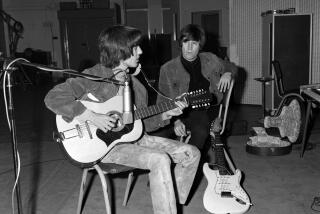Auction Puts a Price Tag on Enron’s Spoils
- Share via
HOUSTON — These were the remnants of a fallen corporate giant: the air hockey tables and leather sofas; the IBMs and the paper shredders; the fleets of ergonomic chairs left empty when thousands of energy workers lost their jobs, and the infamous “E” for Enron.
In a ritual of iconography and free market recycling, Enron Corp. hawked the scraps of its disgraced empire at auction Wednesday. Throngs of curiosity seekers and scavenger hunters packed the ballroom of a chain hotel--and paid hefty prices to get their hands on a souvenir of corporate downfall.
“It’s show and tell,” said Michael Kowalczyk, a hardware specialist who lined up hoping to scoring some cheap computer parts. “People want a piece of Enron.”
True to form, the Enron artifacts carried no warranty--and nothing came cheap. The cash goes straight to creditors--a sliver of the company’s debt, which has climbed higher than $50 billion, spokeswoman Karen Denne said. “This is a drop in the bucket,” she said with a sigh.
When the sun rose Wednesday, former Enron programmer Stephen Bennett pulled on his old Enron T-shirt, slipped a Christian rap CD into his portable disc player and stuck a book about conspiracy theories under his arm. He came to the sale in search of something, but he wasn’t sure what. He’d know it when he saw it, he said--something that would remind him of the old days.
“Owning a little bit of it is a way of stepping on top of it,” he said. “It’s saying, ‘I’ve lasted, I’m above it and I’m still here.’ It’ll be a good lesson down the road.”
People began to gather before dawn. Some came to scrimp on used furniture, and others came to splurge on pricey trinkets. They came to gawk. They came to salvage. And they came thicker than anybody expected. “It’s controlled chaos,” DoveBid project manager Gary Bean said.
More than 1,500 shoppers packed the makeshift auction hall, and hundreds more stood on the hot pavement outside in the hopes of getting in. They shifted their weight all morning, and by noon hotel workers hauled out coolers of ice cream and pitchers of water to relieve the long wait. From 49 states and more than a dozen countries, 12,000 online bidders jammed the auction house Web site.
“We do auctions all the time, and I’ve never seen anything like this,” DoveBid auction director Todd Moutafian said. “These are novice bidders. They need a lot of education and hand-holding.”
Things got rolling with the sale of a $175 basketball hoop. “They worked long days--they needed to relax sometimes,” explained spokesman Eric Thode.
Prices started out inflated--and grew progressively fatter. Used computer screens fetched twice their sale cost. A marble coffee table went for $1,000. “It shows you they’re going crazy,” Bean said, “simply because of the name.” The plasma screens that once piped CNBC and the Weather Channel onto Enron’s frenetic trading floors went for $7,500 each.
There were plenty of scavengers who hoped to flout superstition and seed their own small businesses with the discounted crumbs of Enron. These entrepreneurs hunched intently over their catalogs, circling equipment they needed and muttering into their cell phones to their bosses. As the bids climbed higher, they moaned, raked their hands through their hair and cried, “That’s 3-year-old technology!”
And then came the piece de resistance: The 200-pound, stainless steel “E” that once jutted skyward outside the company’s downtown offices. Set askew on its marble base, the Paul Rand creation was a shiny and familiar landmark at the head of Energy Alley. After the company’s inglorious collapse, the letter was dubbed “crooked E,” a bitter symbol of a band of workers--and a city--defrauded by the fallen energy giant.
“I was going to get it as sort of a reminder,” Houston lawyer John Quindlan said. “I was going to look at it every time I thought about doing a stupid thing. Or a fraudulent thing.”
But as the quotes whisked past $25,000 with barely a pause, Quindlan shook his head and lowered himself into his seat. The statue had proved too pricey, after all.
Within minutes, the Internet bidders dropped back, and two men near the back of the ballroom faced off. Journalists jostled through the crowds to swing their cameras from the face of one bidder to the next. Each new price drew gasps and claps from an adrenalin-driven crowd. The price hit $40,000, and kept climbing.
When Jimmy Luu’s $44,000 bid snagged the looming logo, the crowd erupted in a roaring cheer and Luu’s fist thrust victoriously into the air. His boss at a Houston computer store instructed him to pull out all the stops to get the infamous sculpture, an exuberant Luu explained.
“He said, ‘Just do anything to get it,’ ” he told reporters.
The morning was getting late when Brian Cruver strolled toward the ballroom. Laid off from Enron’s trading floor less than a year ago, the enterprising Cruver went on to cobble his misfortune into a new career.
From the ashes of Enron, Cruver penned a successful book, “Anatomy of Greed: The Unshredded Truth From an Enron Insider.” He arrived at the auction after a jaunt to Winnipeg, Canada, where he filmed a cameo in the made-for-TV movie based on his book. Glancing impassively at the throngs of would-be shoppers--and at a poster for the job fair next door--he quipped that he’d come to recover his onetime chair.
“Getting laid off from Enron,” he said, “was the greatest experience.”
More to Read
Inside the business of entertainment
The Wide Shot brings you news, analysis and insights on everything from streaming wars to production — and what it all means for the future.
You may occasionally receive promotional content from the Los Angeles Times.










